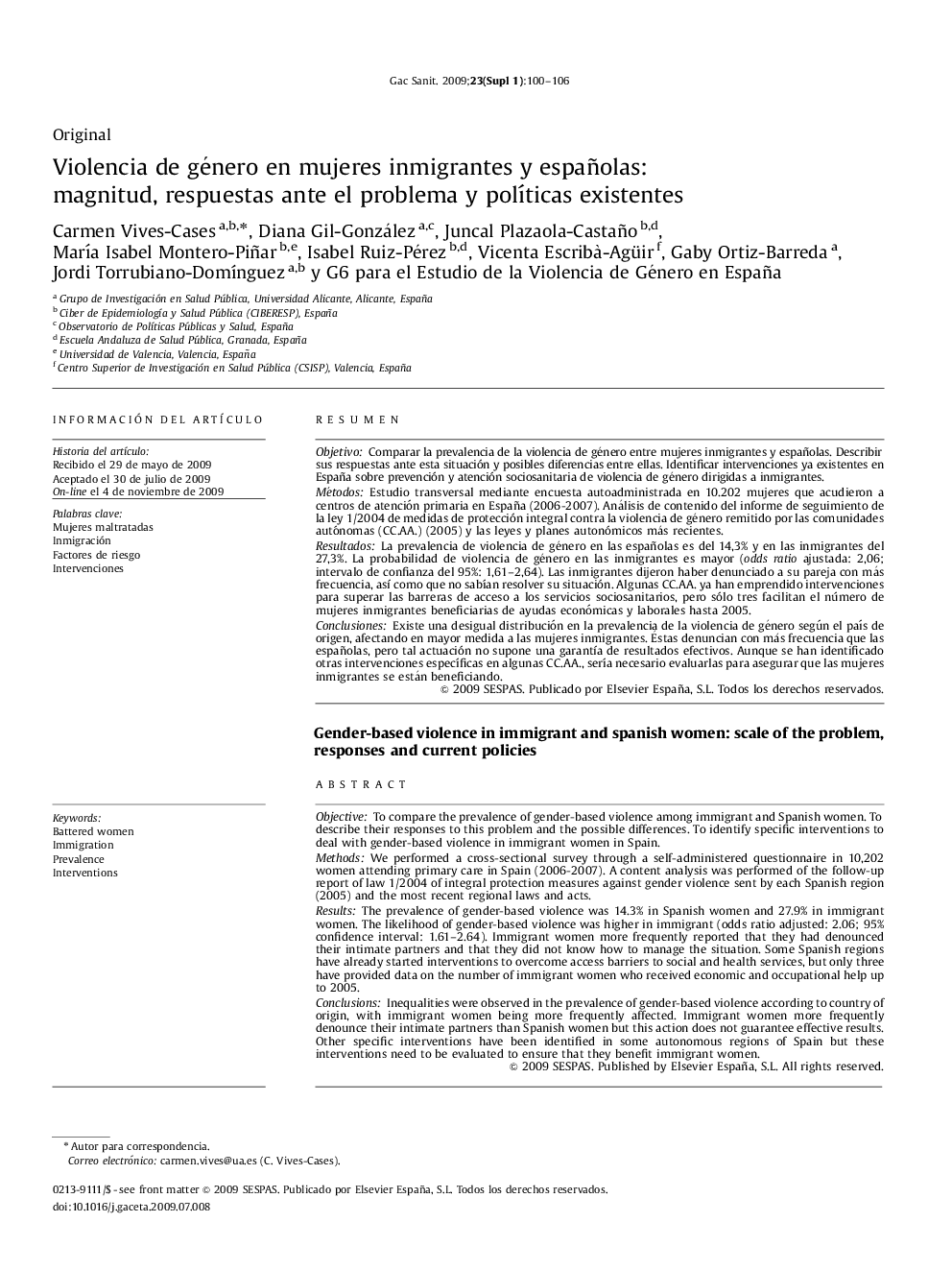| کد مقاله | کد نشریه | سال انتشار | مقاله انگلیسی | نسخه تمام متن |
|---|---|---|---|---|
| 1074085 | 949812 | 2009 | 7 صفحه PDF | دانلود رایگان |

ResumenObjetivoComparar la prevalencia de la violencia de género entre mujeres inmigrantes y españolas. Describir sus respuestas ante esta situación y posibles diferencias entre ellas. Identificar intervenciones ya existentes en España sobre prevención y atención sociosanitaria de violencia de género dirigidas a inmigrantes.MétodosEstudio transversal mediante encuesta autoadministrada en 10.202 mujeres que acudieron a centros de atención primaria en España (2006-2007). Análisis de contenido del informe de seguimiento de la ley 1/2004 de medidas de protección integral contra la violencia de género remitido por las comunidades autónomas (CC.AA.) (2005) y las leyes y planes autonómicos más recientes.ResultadosLa prevalencia de violencia de género en las españolas es del 14,3% y en las inmigrantes del 27,3%. La probabilidad de violencia de género en las inmigrantes es mayor (odds ratio ajustada: 2,06; intervalo de confianza del 95%: 1,61–2,64). Las inmigrantes dijeron haber denunciado a su pareja con más frecuencia, así como que no sabían resolver su situación. Algunas CC.AA. ya han emprendido intervenciones para superar las barreras de acceso a los servicios sociosanitarios, pero sólo tres facilitan el número de mujeres inmigrantes beneficiarias de ayudas económicas y laborales hasta 2005.ConclusionesExiste una desigual distribución en la prevalencia de la violencia de género según el país de origen, afectando en mayor medida a las mujeres inmigrantes. Éstas denuncian con más frecuencia que las españolas, pero tal actuación no supone una garantía de resultados efectivos. Aunque se han identificado otras intervenciones específicas en algunas CC.AA., sería necesario evaluarlas para asegurar que las mujeres inmigrantes se están beneficiando.
ObjectiveTo compare the prevalence of gender-based violence among immigrant and Spanish women. To describe their responses to this problem and the possible differences. To identify specific interventions to deal with gender-based violence in immigrant women in Spain.MethodsWe performed a cross-sectional survey through a self-administered questionnaire in 10,202 women attending primary care in Spain (2006-2007). A content analysis was performed of the follow-up report of law 1/2004 of integral protection measures against gender violence sent by each Spanish region (2005) and the most recent regional laws and acts.ResultsThe prevalence of gender-based violence was 14.3% in Spanish women and 27.9% in immigrant women. The likelihood of gender-based violence was higher in immigrant (odds ratio adjusted: 2.06; 95% confidence interval: 1.61–2.64). Immigrant women more frequently reported that they had denounced their intimate partners and that they did not know how to manage the situation. Some Spanish regions have already started interventions to overcome access barriers to social and health services, but only three have provided data on the number of immigrant women who received economic and occupational help up to 2005.ConclusionsInequalities were observed in the prevalence of gender-based violence according to country of origin, with immigrant women being more frequently affected. Immigrant women more frequently denounce their intimate partners than Spanish women but this action does not guarantee effective results. Other specific interventions have been identified in some autonomous regions of Spain but these interventions need to be evaluated to ensure that they benefit immigrant women.
Journal: Gaceta Sanitaria - Volume 23, Supplement 1, December 2009, Pages 100–106